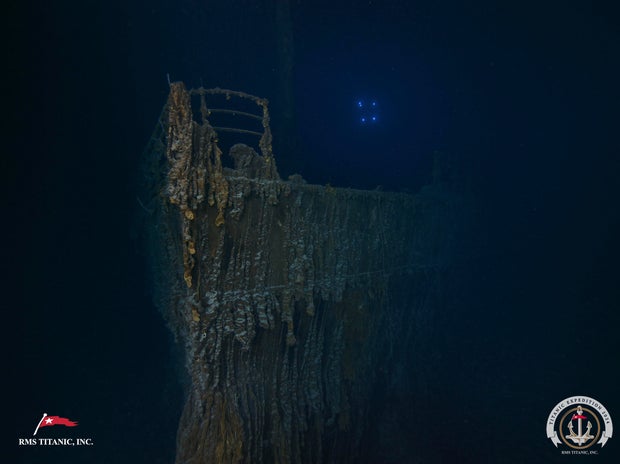Striking new images from a recent expedition to the Titanic wreckage show the decay on the iconic ship’s bow with a large section of railing now on the sea floor, as well as the discovery of a bronze statue from the ship that was feared lost forever.
The railing – immortalized in James Cameron’s 1997 blockbuster film – was discovered during a series of dives by underwater robots this summer.
RMS Titanic Inc., a Georgia-based company that holds the legal rights to the 112-year-old wreck, completed its first trip since 2010 and released images from the expedition on Monday. The pictures show a site that continues to change more than a century later.
RMS Titanic Inc. via AP
“Titanic’s Bow is iconic. It is a haunting image rising from the sea floor as a testament to her strength and defiance,” the company said on its website highlighting the expedition. “The once miraculously intact railing surrounding the Bow’s forecastle deck was missing a 15-foot-long section on the port side.”
Tomasina Ray, director of collections at RMS Titanic Inc., told CBS News partner BBC that the discovery was a “reminder of the deterioration that’s happening every day” at the wreck.
“People ask all the time: ‘How long is Titanic going to be there?’ We just don’t know but we’re watching it in real time,” she added.
Ray told the Associated Press that the discovery only strengthened the team’s commitment to preserving the Titanic’s legacy.
The crew spent 20 days at the site and returned to Providence, Rhode Island, on Aug. 9. They captured more than 2 million of the highest-resolution pictures of the site ever to exist, the company said.
A highlight of the expedition was the discovery of the bronze statue “Diana of Versailles” which was last seen and photographed in 1986 by Robert Ballard, who had found the wreck of the Titanic only a year earlier. The statue – a 2-foot-tall bronze statue that was on display for the ship’s first-class passengers – was discovered lying face-up in the sediment in the debris field.
RMS Titanic Inc. via AP
“It was like finding a needle in a haystack, and to rediscover this year was momentous,” James Penca, a Titanic researcher and presenter of the Witness Titanic podcast, told the BBC.
He said the statue was the centerpiece of the first-class lounge but when the ship split during the sinking, the lounge was opened.
“And in the chaos and the destruction, Diana got ripped off her mantle and she landed in the darkness of the debris field,” Penca added.
The team also fully mapped the wreck and its debris field with equipment that should improve understanding of the site, RMS Titanic said. The next step is to process the data so it can be shared with the scientific community, and so “historically significant and at-risk artifacts can be identified for safe recovery in future expeditions,” the company said in a statement.
Over the years, RMS Titanic Inc. has retrieved thousands of items from the wreck, some of which have been displayed around the world. They plan to return next year to recover more items and would like to bring back the Diana statue.
Penca said the rediscovery of the statue is the perfect argument that the Titanic is a grave site and should be left alone. The ship sank in April 1912 after hitting an iceberg and 1,500 lives were lost.
“This was a piece of art that was meant to be viewed and appreciated. And now that beautiful piece of art is on the ocean floor… in pitch black darkness where she has been for 112 years,” Penca told the BBC. “To bring Diana back so people can see her with their own eyes – the value in that, to spark a love of history, of diving, of conservation, of shipwrecks, of sculpture, I could never leave that on the ocean floor.”



